The 2014 baseball season is finally upon us, and while everyone likes to take their best stab at making predictions, thankfully, no one has any idea how it’s going to turn out — if we did, there’d be no point in watching. With that in mind, we’ve decided that rather than make predictions, we’d rather just talk about the two extremes in a way a season can turn out — the best case and worst case scenarios. Below is a reasonable best case scenario for each Nationals’ player, alongside a reasonable worst case scenario. And we couldn’t help but make a few predictions, wrong though we know they’ll be — you’ll find those at the bottom of the page.
PITCHERS
Aaron Barrett
Best Case: Barrett builds off his remarkable spring, in which he pitched 10.2 scoreless innings with eight strikeouts, by putting together a very strong rookie campaign. After striking out more than 12 batters per nine at AA Harrisburg last year, Barrett fans more than a batter an inning at the big league level. He throws more than 60 innings with an ERA under 3.00, solidifying the sixth inning, and gives the club confidence that he can be used as a set-up man or even a closer in the future.
Worst Case: Barrett’s diving slider, the reason for his success in the minors, doesn’t fool big league hitters, causing his strikeout rate to drop and his walk rate to rise. After giving up runs in his first couple outings, Barrett sits collecting dust at the back of the bullpen, and gets sent down to Syracuse by the middle of May.
Jerry Blevins
Best Case: Blevins does exactly what he was sent to Washington to do — get lefties out. He holds left-handed batters to a .220/.270/.350 batting line (just better than his career averages). But he also has success against right-handers, becoming a reliable southpaw set-up man in the mold of Sean Burnett in 2012.
Worst Case: In 2013, Blevins had a surprising reverse platoon split, allowing a .741 OPS to lefties against a .581 OPS to righties. The trend continues, as while Blevins still manages to be an effective reliever, he cannot seem to put away left-handed hitting. The Nationals still struggle to match up against the tough lefties in their division, like Chase Utley and Freddie Freeman.
Tyler Clippard

Best Case: Clippard continues his six-year run as one of the most successful relief pitchers in the major leagues, throwing 75 innings, striking out 10 batters per nine, and ending up with an ERA around 2.00.
Worst Case: Over the past five years, Clippard has thrown more relief innings than any pitcher in baseball, and the heavy workload finally catches up to him. His strikeout rate, which dropped from 10.4 batters per nine in 2012 to 9.3 in 2013, continues to fall. Clippard had a career low and league low .170 batting average on balls in play last year — that rises, drastically curtailing Clippard’s success. And for the first time in his career, Tyler Clippard spends time on the Disabled List.
A.J. Cole
Best Case: Cole dominated in a 45 inning stint at AA Harrisburg, posting a 2.19 ERA, a WHIP under one and a 9.7 K/9 ratio. His second stint at the level is so successful that after another 45 innings, he forces his way to AAA Syracuse. He dominates there as well, and by September, the 22-year old has earned a call-up to the majors.
Worst Case: Cole spends the entire year at Harrisburg, posting an ERA in the mid-fours and only a league-average strikeout rate. He never seems to master the level in his season in the Eastern League, and is forced to begin 2015 right back at Harrisburg.
Ross Detwiler
Best Case: Detwiler adjusts well to his new role in the bullpen, and gives the Nationals a unique weapon — a left-hander who not only can throw in the mid-nineties, but who can be used as both a long reliever and a situational reliever. His strikeout rate, which stands at 5.4 K/9 for his big league career, nearly doubles out of the bullpen this year.
Worst Case: Detwiler struggles to make the adjustment from pitching every fifth day to pitching out of the bullpen. He is not the dominant reliever the Nationals envisioned, as his strikeout rate fails to improve, and his lack of an effective off-speed pitch still haunts him, even when pitching an inning at a time.
Doug Fister
Best Case: Fister returns from the disabled list in mid-April, and he becomes everything the Nationals envisioned when they made the blockbuster trade to acquire him. The 6’8″ righty still manages to throw 200+ innings, and buoyed by a defense much more agile than the one he pitched in front of in Detroit, nearly equals a career low 2.83 ERA. He proves to be the best fourth starter in baseball, manages to win 18 games, and even receives a couple votes in the Cy Young balloting.
Worst Case: The lat issue proves more serious than Fister and the Nationals had hoped, and while Fister rushes back from the injury, he never fully recovers. He never seems healthy, and is ineffective when on the mound. The lat issue forces Fister to change his mechanics, leading to arm soreness, which causes the Nationals to shut him down in the middle of August. Meanwhile, Robbie Ray ascends rapidly through the Tigers’ minor league system, earning a September call-up, and Steve Lombardozzi hits .298/.369/.411 (his minor-league averages) in 400 plate appearances with the Orioles.
Lucas Giolito

Best Case: Giolito is simply spectacular. He starts the season at low-A Hagerstown, but manages to finish the season at AA Harrisburg after dominating both the South Atlantic League and the Carolina League. His 2014 performance earns him both a place in Baseball America’s Top 10 Prospects list and an invite to major league Spring Training in 2015. A major league debut before his 21st birthday (which will be on July 14th, 2015) becomes a distinct possibility.
Worst Case: The only true worst-case scenario for Giolito would be a recurrence of the elbow injury that required Tommy John surgery in 2012. If Giolito stays healthy for a full season, the Nationals will surely count the season as a success.
Gio Gonzalez
Best Case: Gonzalez’s 2012 season was easily the best by a starting pitcher in the short history of the Washington Nationals — 21-8 with a 2.89 ERA in 199 innings, leading to a third-place finish in the NL Cy Young balloting. While his performance regressed in his second year with the club, the peripheral numbers stayed largely constant — his walk rate stabilized, while his strikeout rate dropped only slightly (the biggest change was a spike in his home run rate, which nearly doubled from 2012 to 2013). The best case scenario for Gonzalez would be a reprise of that 2012 season.
Worst Case: Gonzalez’s walk rate, which has sat around 3.5 BB/9 for the past two years, ticks up to around 4 per nine in 2014. He regresses somewhat, posting an ERA somewhere in the mid-threes — still valuable, but not dominant by any stretch of the imagination.
Taylor Jordan
Best Case: Jordan firmly entrenches himself in the Nationals’ rotation with a powerhouse sophomore season. His pinpoint control keeps the free passes to a minimum, while the slider that has so impressed scouts enable him to put away big league hitters. His ERA hovers around 3.00, and alongside Fister, he gives the Nationals one of the most impressive 4-5 pitching duos in the league.
Worst Case: Before his stellar 2013 campaign, Jordan simply hadn’t been very good in his professional career — in 2012, he had posted a 5.13 ERA as a 23 year old splitting time between short-season A Auburn and low-A Hagerstown. Jordan cannot seem to repeat his 2013 success, as he is hit hard in four big league starts, then gets sent back to AAA Syracuse, where he continues to struggle.
Tanner Roark
Best Case: Roark seemingly came out of nowhere to dominate the major leagues in 2013, posting a minuscule 1.51 ERA in 53.2 innings. While that performance is clearly unsustainable (he gave up only one home run in that time, with a home run/fly ball rate that would have been the lowest in the major leagues had he qualified), he continues to succeed thanks to his low walk rate and high ground ball rate. At age 27, Roark becomes a reliable major league starter, and a part of the Nationals’ future.
Worst Case: Roark’s 2013 turns out to be a fluke — once his home run rate and BABIP normalize, his ERA skyrockets, and Roark quickly finds himself falling out of favor with the Nationals’ brass. When Doug Fister returns, it is Jordan, not Roark, who gets to keep his starting spot, with Roark heading back to Syracuse for a third straight season.
Rafael Soriano

Best Case: Soriano, who spent the offseason working on his slider, finds renewed effectiveness with his breaking pitch. While the fastball is no longer what it was three years ago, Soriano can still use the pitch effectively thanks to the improvement in his off-speed. He posts another 40 save season, and makes the Nationals give serious thought to exercising his club option for 2015.
Worst Case: Last year, Soriano posted the lowest strikeout rate since his rookie season, and with his fastball velocity declining steadily (down almost a mile and a half from two years ago), that does not figure to improve. No longer armed with that blazing fastball, Soriano struggles to put away both hitters and games — each of his save opportunities are nail-biting marathon innings. He loses the closer’s job in June, leaving the Nationals $28 million investment in him looking foolish.
Craig Stammen
Best Case: After a poor (at least by his standards) first half of the 2013 season, Stammen returned to dominance in the second half, holding the opposition to a .228 batting average and posting a 1.41 ERA from the All Star Break on. Stammen picks up right where he left off the year before, striking out more than a batter an inning and using his heavy sinker to get weak contact when batters do connect (his ground ball rate was around 60% last year, the highest of his career).
Worst Case: Stammen, like Clippard, has been used heavily over the past two years, and the cumulative toll of back-to-back 80 relief inning seasons takes its toll.
Drew Storen
Best Case: Storen is the pitcher who returned from minor league assignment and allowed only 3 runs in 19.1 innings; he finally manages to erase the doubts about him that have lingered since Game 5 of the 2012 NLDS.
Worst Case: Storen is closer to the pitcher he was before that minor league assignment, when his ERA sat at 5.95 and he allowed opposing hitters to hit .295/.346/.486. He is once again demoted to the minor leagues, and leaves tremendous doubt that he will be ever become the closer of the future he had been touted as.
Stephen Strasburg
Best Case: Strasburg finally has the breakout year that has been predicted of him since he was at San Diego State. He strikes out 11 batters per nine, has an ERA under 2.5, and most importantly, cracks the 200 inning mark for the first time in his career. He wins the first Cy Young Award of his career.
Worst Case: It seems the worst case scenario for Strasburg in 2014 (aside from a major injury) is a repeat of his 2013. He misses time thanks to some minor injuries, and his numbers, while strong, are be no means transcendent. The league is left wondering whether Strasburg will ever become the player he was expected to be.
Jordan Zimmermann

Best Case: Over the past three years, Zimmermann has posted a 2.58 ERA in the first half of the season; if extended over a full season, that would rank second in baseball, behind only Clayton Kershaw. Zimmermann finally manages to find the same success in the second half as he has in the first, and he ends up as one of the top five pitchers in the National League.
Worst Case: Zimmermann is effective but hardly dominant in the first half of the season, and once again fades in the second half (his second-half ERA over the past three years is 4.33). He goes another 200 innings this year, but with his ERA in the mid-threes, is more of an innings-eater than an ace.
HITTERS
Wilson Ramos
Best Case: Ramos manages to stay healthy, playing in over 120 games for the first time in his career. He also keeps on playing like he did from his return from the Disabled List on July 4th last season, when he hit .276 with 14 home runs and 53 RBIs in 62 games.
Worst Case: While running down the first base line, Wilson Ramos re-tears his hamstring, causing him to miss 60 games. He never really gets healthy, and his power numbers suffer because of it.
Jose Lobaton
Best Case: After Wilson Ramos goes down with an injury, Lobaton steps in and starts 80 games for the Nationals. Lobaton improves on his last season, hitting around .260-.265 with 10 home runs.
Worst Case: Wilson Ramos stays healthy throughout the year, giving Lobaton only 20-30 starts. The lack of playing time hurts Lobaton’s rhythm, causing him to hit below .200 as the back up.
Kevin Frandsen
Best Case: Frandsen returns to his 2012 form, hitting over .270 off the bench, with power. His success causes the Nationals to platoon him with Adam LaRoche at first base, starting Frandsen in games against tough lefties.
Worst Case: Frandsen hits under .220, and fails to replicate the pinch-hitting success he had last year. He is cut by the Nationals mid-June in favor of Tyler Moore.
Adam LaRoche

Best Case: Adam LaRoche shows that 2013 was a fluke, and while he can’t to replicate his incredible 2012 season, his batting average and slugging percentage return to their career norms. He also manages a .244/.300/.439 against left-handed pitching (his career averages), meaning he plays his way out of a platoon.
Worst Case: Age continues to take its toll on the 34 year old first baseman, and LaRoche’s numbers continue to decline. The Nationals have to remove him from the lineup against tough lefties. LaRoche’s struggles cause the Nationals to decline his option, leaving them without a solution at first base heading into 2015.
Danny Espinosa
Best Case: Anthony Rendon struggles out of the gate, causing the Nationals to start Espinosa more often. In the starting role, Espinosa finally is able to hit consistantly from both sides of the plate and by midseason, Espinosa regains the role of starting second baseman. Espinosa cuts down on his strikeouts, while his power swing returns, and he hits 20 home runs for the second time in his career.
Worst Case: Espinosa’s 2013 was the worst possible scenario for him — he hit below the Mendoza Line, dealt with wrist injuries, and lost his starting job to Anthony Rendon, perhaps for good. In 2014, the offensive struggles continue, and though his defense still draws rave reviews, the Nationals cannot continue to put his bat in the lineup. They once again demote him to AAA, then end up trading him to the Astros.
Anthony Rendon
Best Case: Rendon improves on his strong rookie year; he raises his average over the .280 mark, and is finally able to find his power swing at the major league level, hitting 20+ home runs. He also gets more comfortable at second base in his second year, cutting his errors in half.
Worse Case: Rendon’s injury problems that let him slip to the 6th pick in the 2011 draft return, as Rendon has troubles staying on the field throughout the season. While Rendon is off the field, Espinosa takes over at second, and shows the Nationals why he should have been the starting second baseman all along. When Rendon finally gets healthy, he finds himself sitting on the bench behind Espinosa.
Ryan Zimmerman
Best Case: Zimmerman manages to stay fully healthy, avoiding the DL for the entire season for the first time since 2010. He comes out of the gate showing the power that he flashed last September, hitting 18 home runs by the All Star break. His throwing woes gone, he also improves defensively, allowing the Nationals to keep him at his natural position of third base for the forseeable future.
Worst Case: Zimmerman still cannot seem to shake the throwing problems that have dogged him for the past three years, committing a league-leading 18 throwing errors. Worse yet, Zimmerman, a very streaky hitter, never seems to get truly hot, and finishes with an OPS under .800. He ends up playing the majority of September at first base.
Ian Desmond
Best Case: Desmond builds on his recent success; he hits 28 home runs and steals 25 bases, becoming a member of the 20-20 club for the third straight season. He is able to stay on the field for the entire season, playing in more than 150 games. His success leads to his second all-star performance and his third silver slugger.
Worst Case: Desmond’s performance dipped in most major offensive categories from 2012 to 2013, and it continues to dip in 2014. He plays in 145 games and hits .270/.310/.420 — good numbers for a shortstop, but hardly all-star caliber. He begins to regret not signing the 7 year, $90 million deal the Nationals placed in front of him in the offseason.
Zach Walters

Best Case: Walters works on his defense in the minors, and thanks to Danny Espinosa’s struggles, finds himself in the majors by June. Shifted into the utility infielder role, Walters shines, hitting 10 home runs in 250 at-bats. He establishes himself as a talent worthy of a starting job in the major leagues.
Worst Case: Both Danny Espinosa and Anthony Rendon put together solid seasons, leaving no room for Walters in Washington until September.
Scott Hariston
Best Case: Hariston does what he was brought to D.C. to do; kill lefty pitchers off the bench. He slugs .500 against left-handed pitching (in line with his career average), getting some key hits off the bench, and even earns himself a couple of spot starts a week.
Worst Case: Hariston hits .177 in the first two months of the season, and it seems like the end of the road for the 11-year MLB veteran. Because of his struggles, the Nationals decide to cut ties with Hariston, releasing him mid-June.
Bryce Harper
Best Case: Bryce Harper proves that when he is healthy, he is the best player on the planet. He hits over .300 for the majority of the season, and finishes the season with over 40 home runs. His great season doesn’t just earn him an all-star game start and a silver slugger award, but it also wins him the NL MVP.
Worst Case: Held back by injuries and his struggles against lefties, Harper fails to make the jump from stardom to superstardom. He plays in 120 games and hits .280 with 25 home runs — fantastic numbers for any other 21 year old, but they fail to live up to the lofty expectations the media has for Harper, and Harper has for himself.
Nate McLouth
Base Case: McLouth sees significant playing time, and makes the most of that playing time, hitting .260 with 10 home runs and ranking among the team leaders in stolen bases.
Worse Case: McLouth only sees the field as a pinch hitter, and doesn’t get much time in the field. He regresses to something resembling the form he displayed in 2011 (when he hit .228/.344/.333), and the Nationals regret being stuck with him for the 2015 season.
Tyler Moore
Best Case: In the minors, Moore is able to find his groove, hitting over .300 with 15 home runs in the first two months of the season. After Hariston is released, Moore is called up to replace him on the bench.
Worse Case: Moore struggles in the minors, causing him to stay there until September. The organization accepts that Moore is not a part of their long term plans, and looks outside the organization for Adam LaRoche’s replacement.
Denard Span

Best Case: Span is able to recreate his September performance (when he hit .316/.352/.412 in the teams last 29 games) over a full season. Under new manager Matt Williams’ tutelage, Span finally learns to be aggressive on the basepaths, swiping 40 bags for the first time in his career. He continues his impeccable play in center field, earning him his first career Gold Glove.
Worse Case: Span plays like he did for the majority of last season, forcing Matt Williams to move him to the eighth hole in the lineup. Because he can’t get on base, he can’t steal bases, ending up with only 15 on the season. Span’s platoon problems (he had a .539 OPS against lefties last year) continue, and by August, he no longer starts against left-handed pitching.
Jayson Werth
Best Case: Werth proves that 2013 was no fluke, hitting .310 with 26 home runs. Werth manages to stay healthy, playing in over 140 games for the first time since 2011. On top of that, Werth makes the all-star team for only the second time in his career, and finishes top-20 in MVP vote for the fourth time.
Worse Case: Werth’s injuries continue, as a now 35 year old Werth plays in fewer than 130 games for the third straight year. He also returns from the spectacular heights of 2013 to his career averages, and hits a respectable-but-unspectacular .265/.355/.440 in the 2014 season. His 2014 play reignites the debate over the $126 million contract the Nationals gave him in 2011.






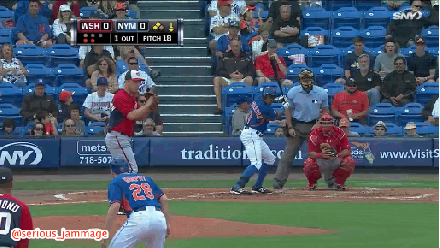



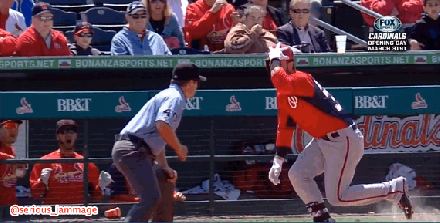


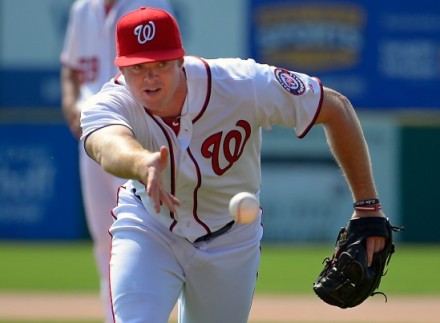



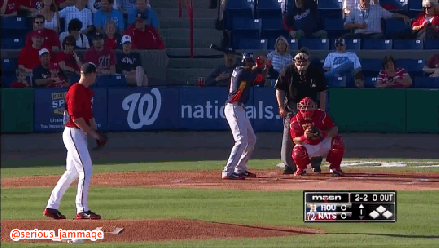
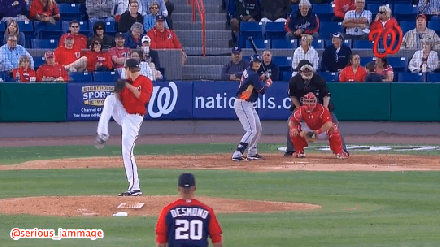

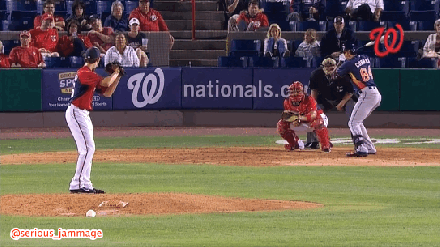
 Coming into spring training, the Washington Nationals’ Opening Day rotation seemed all but decided. Stephen Strasburg would start game one, to be followed in some order by Gio Gonzalez, Jordan Zimmermann, Doug Fister, and 28-year old southpaw Ross Detwiler. Of the five, Detwiler was the least sure thing — he suffered from a serious back injury in 2013, making only 13 starts (none after July 3rd) and putting up a mediocre 4.04 ERA. But before the injury, Detwiler, a first-round pick in 2007 who had struggled early in his major league career, had seemingly realized his potential to become an above-average starter for a high-quality rotation. In 2012, Detwiler’s only full season in the big leagues, he managed an impressive 3.40 ERA in more than 164 innings, utilizing a sinking fastball that averaged 92.7 MPH to post a groundball percentage over 50%. Furthermore, in the fabled Game 4 of the 2012 NLDS, Detwiler put together a performance that ranks among the greatest starts in Nationals’ history:
Coming into spring training, the Washington Nationals’ Opening Day rotation seemed all but decided. Stephen Strasburg would start game one, to be followed in some order by Gio Gonzalez, Jordan Zimmermann, Doug Fister, and 28-year old southpaw Ross Detwiler. Of the five, Detwiler was the least sure thing — he suffered from a serious back injury in 2013, making only 13 starts (none after July 3rd) and putting up a mediocre 4.04 ERA. But before the injury, Detwiler, a first-round pick in 2007 who had struggled early in his major league career, had seemingly realized his potential to become an above-average starter for a high-quality rotation. In 2012, Detwiler’s only full season in the big leagues, he managed an impressive 3.40 ERA in more than 164 innings, utilizing a sinking fastball that averaged 92.7 MPH to post a groundball percentage over 50%. Furthermore, in the fabled Game 4 of the 2012 NLDS, Detwiler put together a performance that ranks among the greatest starts in Nationals’ history: